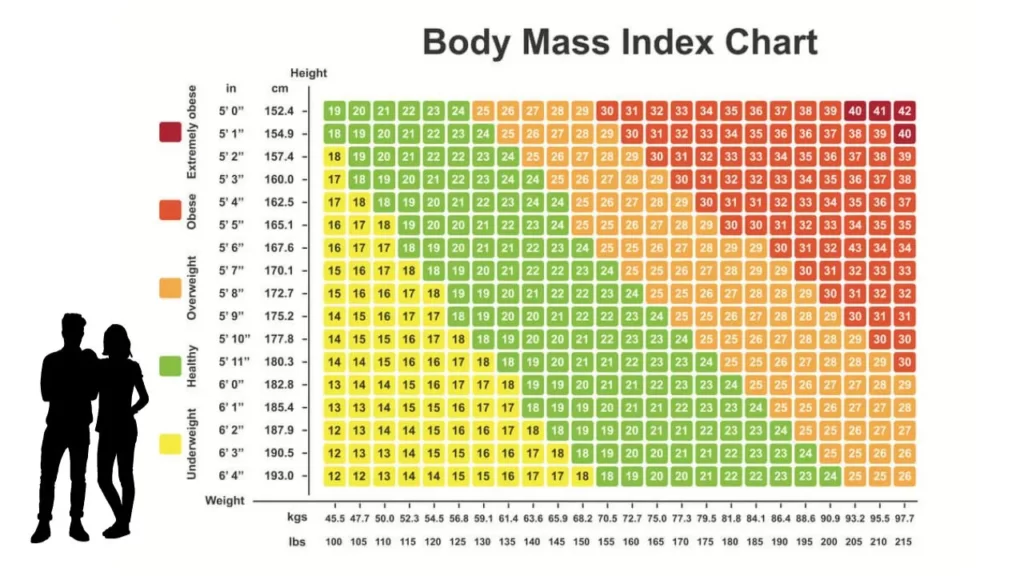BMI Calculator
Related: Water Intake Calculator
BMI Indicator Parameters
| BMI Range | Indicator |
|---|---|
| 0 - 18.4 | Underweight |
| 18.5 - 24.9 | Normal Weight |
| 25 - 29.9 | Overweight |
| 30 - 34.9 | Obesity (Class 1) |
| 35 - 39.9 | Obesity (Class 2) |
| 40 - 100 | Obesity (Class 3) |
Body Mass Index (BMI) Calculator: Everything You Need to Know
When it comes to assessing your health and well-being, measuring your body mass index (BMI) is one of the most useful tools (BMI Calculator) at your disposal. In this article, we will explain what a BMI calculator is, why it is important to measure, and how you can use it to achieve your health goals.
What is BMI?
BMI is a body composition measure based on a person's weight and height. It is calculated by dividing your weight (in kilograms) by your height (in meters) squared. The resulting number is your BMI score.
BMI determines whether a person is underweight, normal weight, overweight, or obese. These categories are based on established ranges of BMI scores that are associated with different levels of health risk.
The Importance of Measuring BMI
BMI is an important tool for assessing your overall health and well-being. Research has shown that BMI is strongly linked to various health outcomes, such as cardiovascular disease, diabetes, and certain types of cancer.
By measuring your BMI, you can get an idea of whether you are at a healthy weight for your height. This can help you identify any potential health risks and take steps to improve your overall health.
How is the Body Mass Index (BMI) calculated through the BMI Calculator?
BMI is calculated by dividing a person's weight in kilograms by the square of their height in meters. The formula for calculating BMI is as follows:
BMI = weight (kg) / height² (m²)
For example, a person who weighs 68 kg and is 1.75 meters tall would have a BMI of 22.2:
BMI = 68 / (1.75 x 1.75) = 22.2
Understanding Your BMI Results
Once you have calculated your BMI, you can use the following table to interpret your results:
| BMI | Category | Health Risk |
|---|---|---|
| <18.5 | Underweight | Increased risk |
| 18.5-24.9 | Normal weight | Lowest risk |
| 25-29.9 | Overweight | Increased risk |
| 30-34.9 | Obese (Class I) | High risk |
| 35-39.9 | Ob |
Read Articles on Weight Loss

Why is it important to measure your Body Mass Index (BMI)?
Measuring your BMI can help you determine whether you are at a healthy weight for your height. Being overweight or obese can increase your risk of developing a range of health problems, including heart disease, stroke, diabetes, and certain types of cancer. By monitoring your BMI, you can take steps to maintain a healthy weight and reduce your risk of developing these health problems.
What are the pros and cons of using the Body Mass Index (BMI) calculator?
Pros:
- Quick and easy to use
- Provides a rough estimate of body fat
- Can be used to identify weight categories that may lead to health problems
Cons:
- Does not take into account muscle mass or body composition
- May not be accurate for athletes or people with a lot of muscle mass
- Does not account for differences in age, gender, or ethnicity
How to interpret your Body Mass Index (BMI) results?
Once you have calculated your BMI, you can use the following categories to interpret your results:
- Underweight: BMI below 18.5
- Normal weight: BMI between 18.5 and 24.9
- Overweight: BMI between 25 and 29.9
- Obese: BMI of 30 or higher
Who should use the Body Mass Index (BMI) calculator?
The BMI calculator can be used by anyone who wants to monitor their weight and assess their overall health. However, it is important to
However, it is important to note that BMI is not always accurate for everyone. Athletes and people with a lot of muscle mass may have a higher BMI, even if they have a healthy body fat percentage. Additionally, BMI may not be as accurate for older adults or people from certain ethnic groups.

